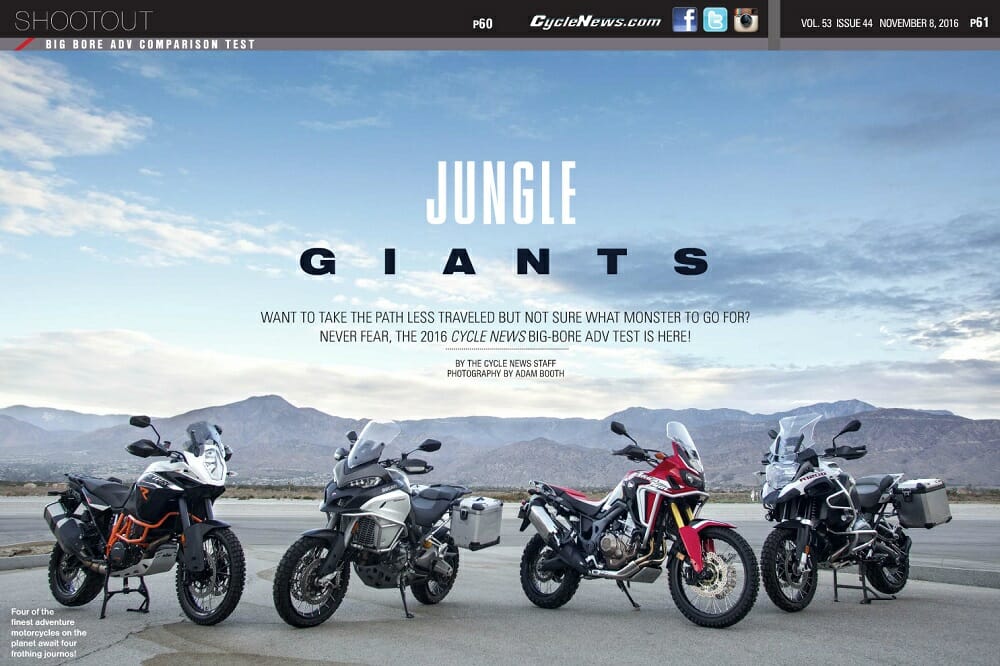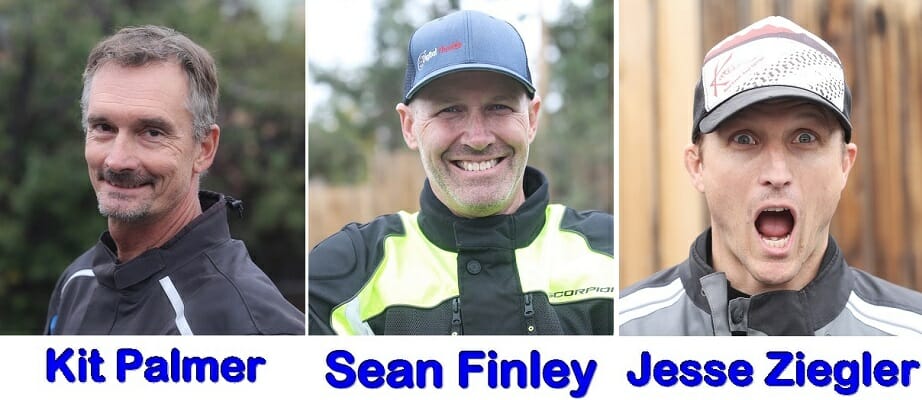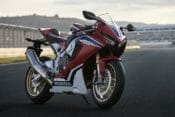Want to take the path less traveled but not sure what monster to go for? Never fear, the 2016 Cycle News Big-Bore ADV test is here!

Have ADV bike, will travel! That’s what the world’s leading motorcycle manufacturers want. They want you to find your inner Ewan and Charlie and head for far-off lands on big bikes with dreams in your heart and cash in your wallet.
And should you indeed follow those dreams—or just a snaky weekend away with the wife—you might want to consider any of these four machines as your choice of steed.
To read this in Cycle News Digital Edition, click HERE
These bikes on test here are the cream of the big-bore ADV crop. Honda’s new Africa Twin, KTM’s soon-to-be-replaced 1190 Adventure R, the new Ducati Multistrada Enduro and the venerable BMW R 1200 GS Adventure—these are serious machines designed to take you anywhere your little heart desires. We do acknowledge we are missing from the test the Triumph Tiger Explorer, Suzuki V-Strom and ancient Yamaha Super Tenere, but we felt we should whittle this test down to the best of the best in the category—so here we are.
Our test loop had us traversing Big Bear National Park in Southern California for a couple of days, intermixed with the beer-drinking arguments that are a prerequisite to determine an overall winner. Our focus was mainly on the dirt, with good doses of tar riding thrown in. These bikes are meant to go off road, after all.
So without further ado…
The Testers
|
Job title: Cycle News Editor |
Job title: Co-owner of Cycle News |
Job title: Co-owner (the good part) of Cycle News |
|
Age: 55 |
Age: 47 |
Age: 39 still! |
|
Experience: Started riding motorcycle at eight; first time on a bike didn’t go well but he loved it anyway. Considers himself a dirt-bike guy but rides on the street nearly every day. Raced motocross for many years until he caught the enduro bug (then the hare and hound bug, then the hare scrambles bug…) Bottom line, if it has two wheels, he enjoys riding it. |
Experience: Riding since his parents bought him a Honda MR50 at age five. Racing since age 14 (if you count three-wheelers and quads) but followed that up with a lot of years of motocross and off-road racing. A lot of ADV miles including two-up trips with his wife. |
Experience: Started riding dirt bikes at five, raced his first motocross race at 17 and has been evaluating motorcycles full-time as a magazine editor since 2005. Arguably has too many ideas of what the perfect motorcycle is. Also has the cutest daughter in the world. |
4th Place—Ducati 1200 Multistrada Enduro
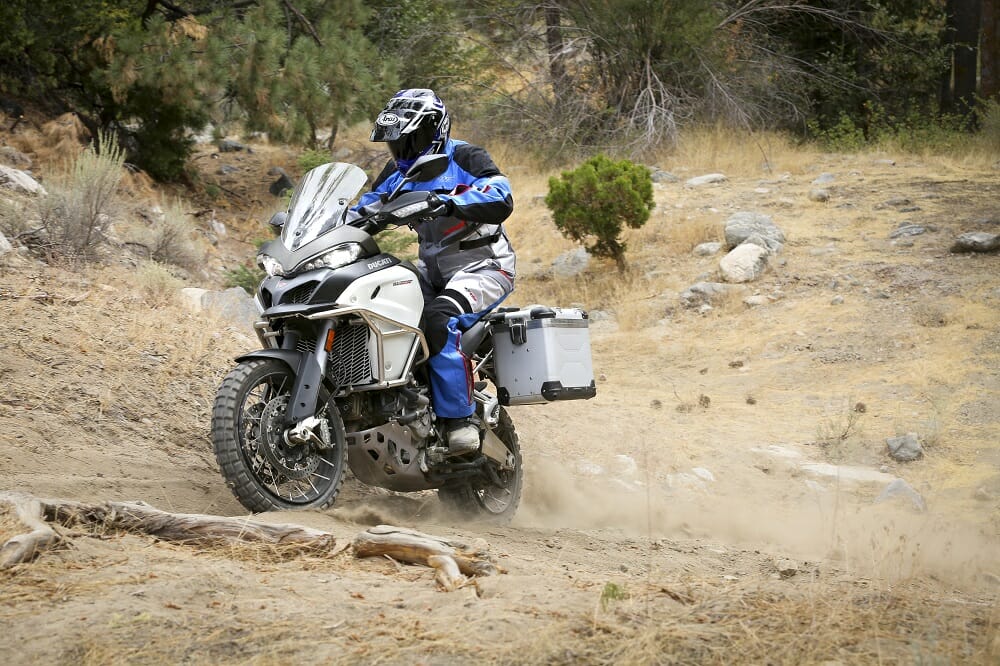
This year was significant for Ducati in that it was the time they truly attacked the predominately dirt side of the ADV category. The Multistrada had always been capable of going off road, but now with a proper dirt-focused 19-inch front wheel, it finally had the chops to take it to the established ADV stars.
It was good to see the Ducati had lost almost none of its on-road prowess in being enduro-ized, with all the testers praising how good the chassis balance and engine power delivery were on the street. Despite being by far the heaviest in the test, the Ducati’s poise off road was surprising and it more than held its own on average fire roads—only when we started to get into some really technical areas did the Ducati begin to lose touch with the other bikes as the weight made low-speed maneuvering a touch difficult.
The Ducati’s engine was a talking point. Despite being derived from a superbike, the 11° motor’s initial throttle response in Enduro mode was too soft in the dirt and not as direct as the KTM or the BMW, both of which also have variable engine modes compared to the single mode on the Honda. Get it wound up on the road, however, and it’s easy to see where the Ducati’s engine heritage lies—it’s damn fast.
The ergonomics were pretty good and with the lowest seat height here, that makes the Ducati more appealing to shorter riders.

One thing we could all agree on was the fact the electronics were simply too confusing and too numerous to really get a handle on, similar to the KTM. These options all work well and deserve a place on such a premium bike, but accessing them takes too much time, especially if you want a quick change-and-go while out on the trail.
The engine is by far the most enjoyable of the bunch on the street—that bullish induction roar is something we all loved, and there’s power to burn in the higher rev ranges, making this an excellent long-range tourer. It does still have that asthmatic wheeze on startup and sounds like the starter motor is barely turning the engine over, but that’s just a Ducati personality trait.
The most expensive bike of the bunch is not enough to knock off the other three if you’re doing both on- and off-road. If you stay on road, there’s a good argument for the Multi, but then again, the standard, 17-inch wheel Multi will outperform this version, so it’s a tough sell.
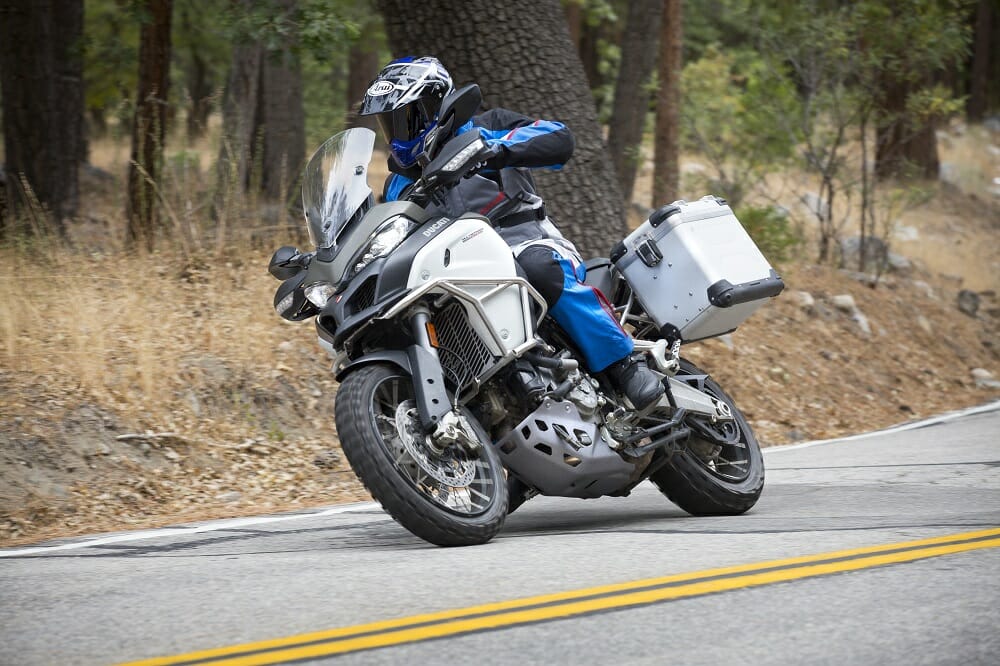
Jesse Ziegler: “The bike sounds like a trophy truck on the fun and twisty dirt roads we were riding! After custom-tuning some modes (talk about a confusing array of options), the bike was roosting just right and stopping adequately. After getting off the Honda, this thing was like taking an exam to get the electronics the way I wanted. Still, it has the trickest dashboard electronics to go with those choices and that feels good. Like the BMW, the Multistrada suffers from the extra girth in the softer sections of off-road riding but makes up for it in stability everywhere else. Ergonomics are unique on the Duc’ with a favoritism leaning to the sportbike world. This bike wants you to be up-on-the-tank on the road and the bar and peg positions force a somewhat awkward standing posture as well.”
Sean Finley: “The Ducati is slightly compact feeling and the relatively low seat height make the bike feel smaller and lighter than it is on the road. The motor is extremely fun and has the best exhaust note of the bikes tested. The Ducati also has very predictable manners on the road that provide the confidence to push it hard as soon as you hop on. The electronics options for the engine map, suspension settings and braking provide all of the versatility you could ever want from a motorcycle, although they are hard to access quickly. The hand guards with integrated turn signals are great for the street but will be easily damaged in a tip-over, which is very likely when riding in the dirt.”
Kit Palmer: “I have to say that I was truly blown away by how well the Ducati handled the dirt for such a large and heavy motorcycle. The dirt-bike-like ergos go a long way in making the Ducati feel at home off the pavement. You do feel, however, because of the low seat height, like you’re sitting well in the bike rather than on top of it, which feels a bit odd at first if your riding background is more off-road than on. It’s no surprise the Ducati is a blast on the street, the curvier the roads the better, and the engine is powerful and sounds just plain awesome! It makes you want to open up the throttle whenever you get the chance. My biggest gripe? Accessing the electronics—makes you not want to use it at all. Still, the Ducati surprised me—and in a good way—the most of the four.”
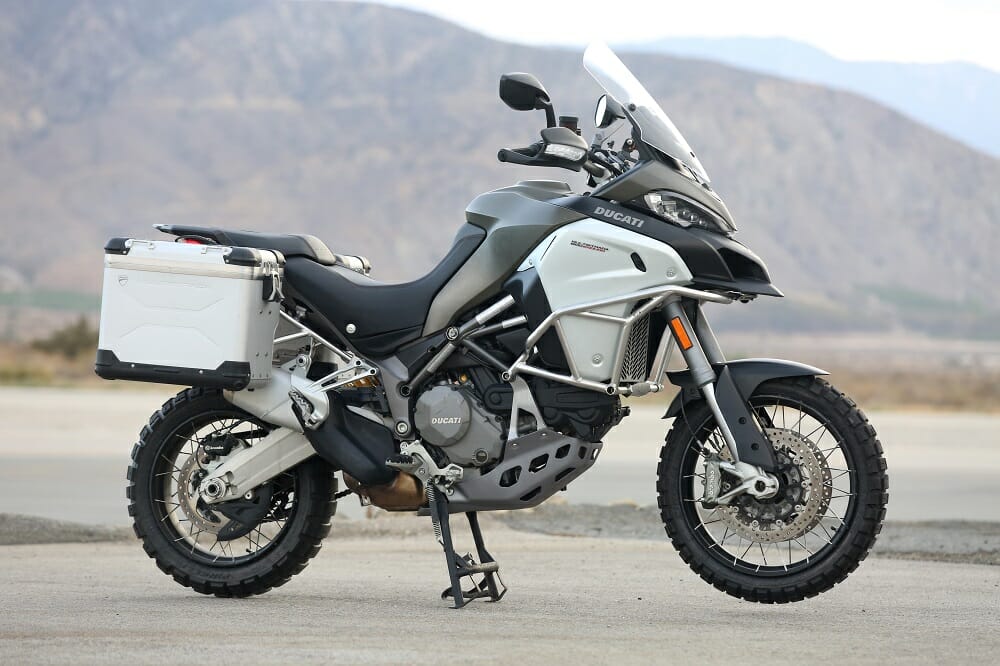
The Vitals: Ducati 1200 Multistrada Enduro
|
Engine and gearbox: |
1198cc, Desmodromic L-twin six-speed |
|
Chassis, suspension and brakes: |
Tubular steel trellis chassis, 48mm Sachs electronically adjustable forks and Sachs monoshock, Brembo radially- mounted four-piston front brake calipers and 320mm discs, twin-piston rear caliper and 265mm disc |
|
Seat height: |
34.3 in. |
|
Fuel Capacity: |
7.9 gal. |
|
Weight: |
566 lbs. (wet, claimed) |
|
Electronics: |
Ducati Traction Control, Cornering ABS, four variable power modes, riding modes, Ducati Wheelie Control, cruise control, LED headlights with Cornering Function |
|
Power: |
160 hp @ 9500 rpm (claimed) |
|
Torque: |
100 lb-ft @ 7500 rpm |
|
MSRP: |
$21,495 (base, no accessories |
3rd Place – BMW R 1200 GS Adventure
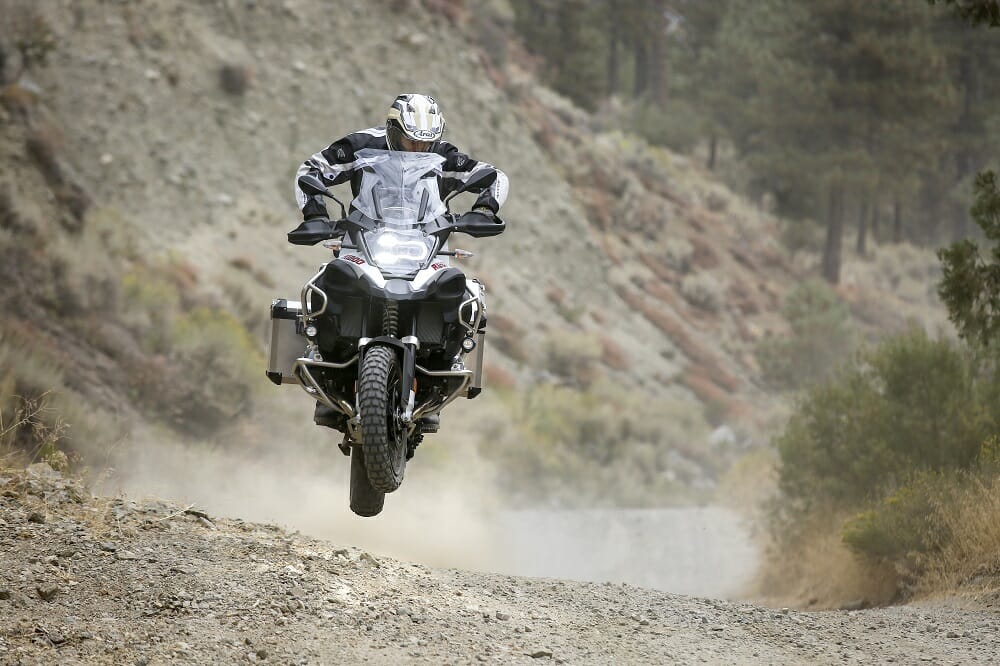
Hands down, the BMW R 1200 GS Adventure is the best of this quartet on the road. Low center of gravity, every creature comfort but the kitchen sink, excellent elements protection and a motor so smooth it may as well be called the silk road; the biggest of all, off-road Beemers never fail to disappoint—if you never go off-road.
This is truly a massive bike, a far cry from the svelte nature of the KTM and Honda and certainly porkier (in feel, not overall weight) than the Ducati. Despite this fact, the Beemer is a beauty on road. It’s stable as a rock (if a little slow in the steering), the ESA (Electronic Suspension Adjustment) takes care of road corrugations with ease, throwing waves of confidence at the rider. I’ve seen some riders do some pretty amazing things with a GSA on the tar.
Off road, the sheer girth of the bike becomes more apparent. You’ve got to be careful in anything other than hard-packed dirt because what aids the bike on the tar—the low center of gravity—can make the GSA a bit of a handful when riding over sharp rocks, tree stumps and the like.

But there is a plus to the GSA in that the boxer twin motor has a beautifully mapped fuel-injection system and slow speed, small openings don’t set the bike off in a nervous course and just allow it to plow through its chosen path.
The boxer layout also makes the bike feel very wide (it is, anyway), and as the tallest rider of the bunch, Kit, hated continually hitting his shins on the cylinders.
Like the Ducati, there’s an enormous array of electronics available (riding modes, traction control, ABS, cruise control, heated grips…), but they seem to be a little more intuitive on the BMW, a little easier to understand and adjust. Little things like the position and function of the cruise-control switch, the faster warming and hotter heated grips over the Ducati and KTM and easy switchability of the TC and ABS make the GSA a fantastic machine.
This is the big daddy of the ADV range and even though you can ride this bike into some pretty gnarly areas, most won’t, instead focusing on the blacktop and a bit of dirt road riding. If this were a pure road ADV test, the GSA would have won—no question.
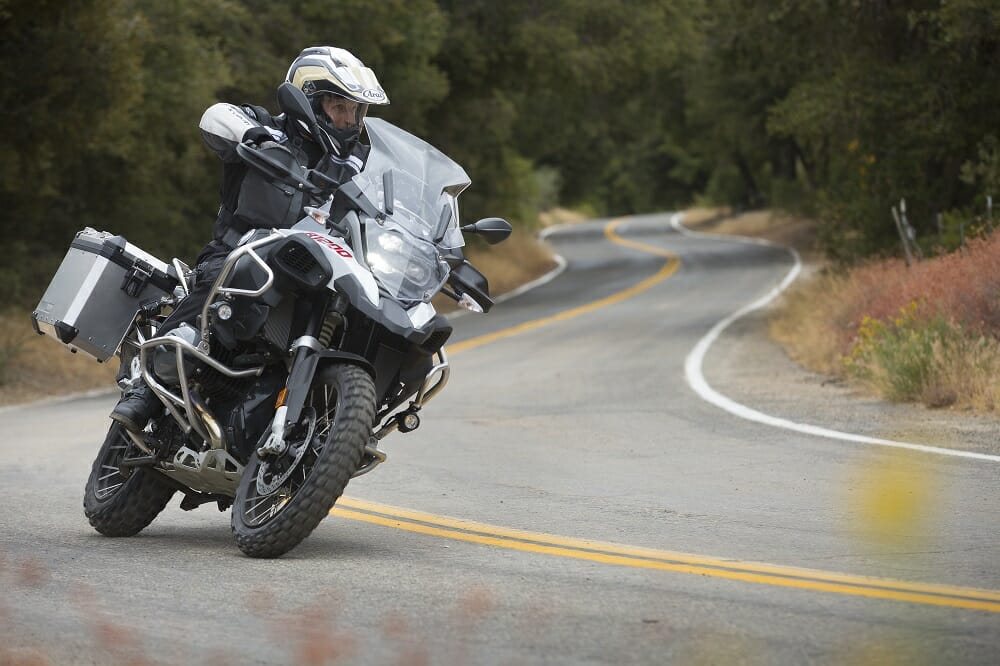
Jesse Ziegler: “That extremely planted feel carries over effortlessly to the smooth and widest dirt road sections we rode as well as the more technical off-road areas that didn’t suffer from too much loose or truly nasty off-road ground cover. Only on the softer sand sections does the very excellent road-biased front-end geometry start to wallow. Also, here is where you can really feel the burden of the massive tank full of fuel. However, the big Beemer isn’t as bad off-road as it may seem on paper or feel when you roll it around the shop. In reality, the BMW is solid, totally fine in the dirt as long as you respect physics’ limits and is clearly the most comfortable of these bikes for touring. It is the grand master of the touring segment with the historical ADV chops to traverse the backcountry.”
Sean Finley: “If you will be primarily riding on the road with the occasional dirt road, the BMW R1200 GS Adventure is the one. The motor favors low rpm riding and will accelerate out of corners with impressive force. The sitting position and ergonomics are a little different than the other bikes in the test and the most comfortable for a long day of riding. The electronics and dash provide a lot of options for ride modes and suspension settings as well as all the information you could ever want. But the BMW is the most difficult to ride in sand and the relatively low ground clearance and wide engine make tougher trails a challenge. If that is the kind of riding you favor, the BMW can get through it but not as easy as the Honda and KTM. The electronics and dash require some practice to master all the options. The wide seat and motor make the bike feel big.”
Kit Palmer: “The BMW is a big motorcycle that requires a lot of respect on the dirt, but the more you ride it, the more you get used to it. Those protruding cylinders irritate the heck out of me at times when riding off-road. Uniquely positioned the way they are helps give the bike a low center of gravity, which in turns improves handling, but try telling that to my shins. The suspension is remarkably good in the dirt and the engine is very compliant both off and on the road—there’s tons of power on tap. The road is where the BMW really shines. It’s extremely comfortable and can be ridden mile after mile without any hint of complaint from your back or legs. Even if I had no intentions of touching dirt, I would seriously consider the BMW as my one-and-only street bike.”
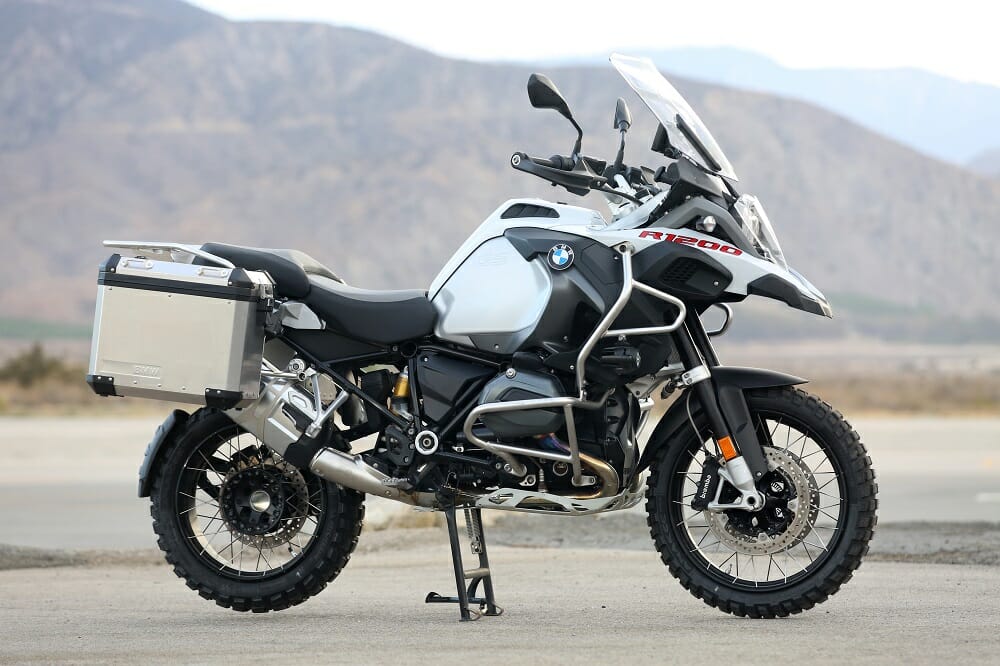
The Vitals: BMW R 1200 GSA
|
Engine and gearbox: |
1170, Boxer-twin, six-speed |
|
Chassis, suspension and brakes: |
Tubular steel bridge chassis, Telelever front suspension and Paralever rear suspension, radially-mounted four- piston front brake calipers and 305mm discs, twin- piston rear caliper and 265mm disc |
|
Seat height: |
35 in. |
|
Fuel capacity: |
8.7 gal. |
|
Weight: |
564 lbs. (wet, claimed) |
|
Electronics: |
Electronically adjusted suspension (ESA), ABS, traction control, heated hand grips, cruise control, four variable engine maps |
|
Power: |
110 hp @ 7750 rpm (claimed) |
|
Torque: |
89 lb-ft @ 6000 rpm |
|
MSRP: |
$18,695 (base, no accessories) |
2nd Place – KTM 1190 Adventure R
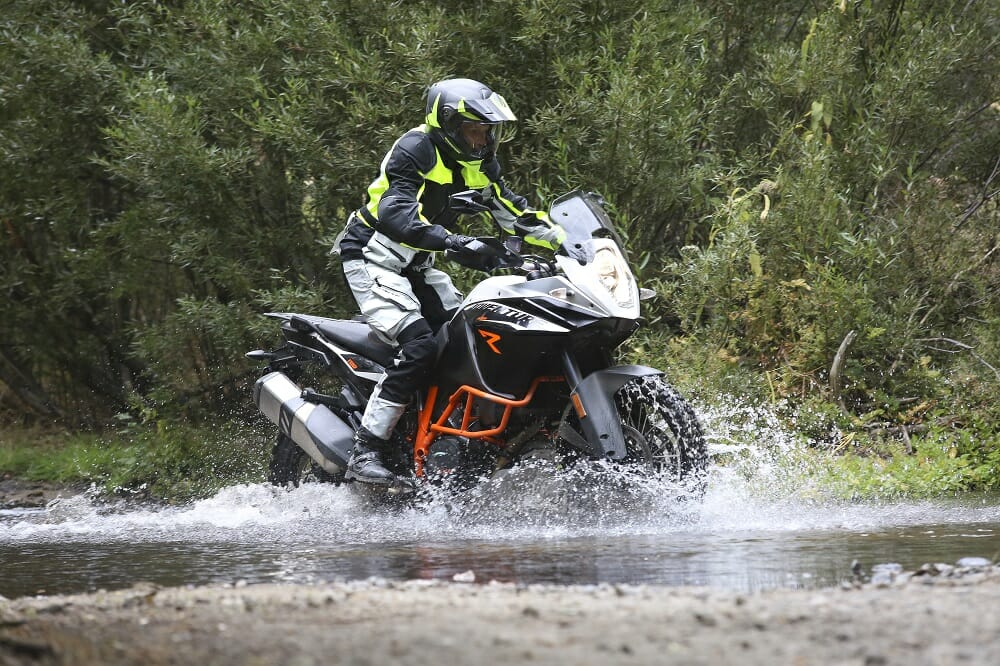
This is what Ryan Dungey would race should ADV bikes be let into Monster Energy Supercross next year. The KTM feels like it was spawned from racetracks; it’s got that Ready To Race persona that’s far more exciting than anything else here in the test.
The 1195cc V-twin motor pumps out stupendous horsepower and will leave the rest of these bikes in its wake. There’s grunt everywhere, and it’s not exceptionally mitigated by the addition of the four engine maps (Sport, Street, Rain and Off-Road). If anything, the KTM is the more expert of the bikes on this test. It feels designed for riders willing to take it into gnarly areas way more than the BMW or Ducati.
Over the years KTM has slowly changed the Adventure persona (starting back in the 950 and 990 days) into one that will more accommodate the road-oriented rider—the suspension is plusher than ever, and there’s a dazzling array of electronics that are, sadly, still a pain in the ass to navigate quickly. They will also default to whatever the factory setting is unless you have the ABS/TC dongle (which I have on my SuperDuke), and that can drive you nuts.
It’s not the best on the road in this test—the motor still has that KTM trait of radiating too much heat back to the rider and the seat, while good for short stints on the trails, becomes super hard after a big tarmac session. It’s also rather tall in the seat, which makes it a pain for short riders. The wind protection also lags behind the BMW and Ducati on the road.

But where the KTM shines is still the terrain it was designed for—the dirt. The KTM has the most confidence-inspiring chassis of the lot, and allows even piss-weak off-road riders like me the chance to feel a little bit special. It’s tall, long but not as heavy as it looks, and responds beautifully to everything from slow-speed maneuvering through trees and rocks to fast, sweeping fire trails drifting sessions.
Aesthetically the KTM looks absolutely on-point, ready to take on the Dakar (in the spectator lanes). Another argument is because this motor is being discontinued next year, these 1190 machines will be in dealers at a steal for the next few months.
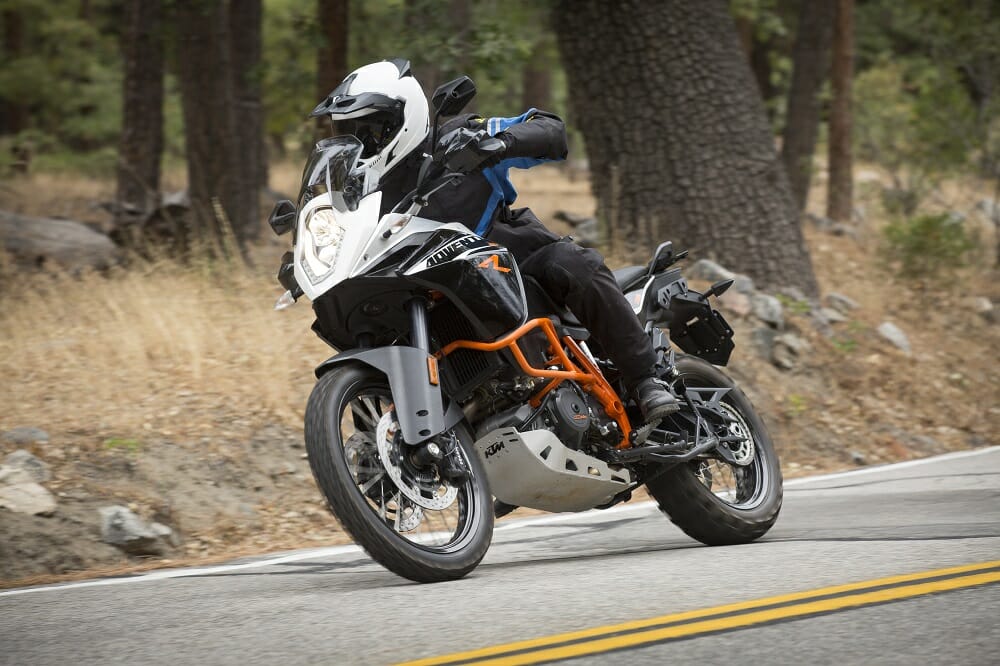
Jesse Ziegler: “On the street, this KTM suffers from some of the same old KTM complaints—it’s hot in the seat, there isn’t as much wind protection as others, its seating and peg position isn’t great for big miles, it’s hard to touch the ground at stoplights, and the like. But maybe that’s not what KTM cares about, because it’s an awesome off-road bike. I think the focus on making this bike better on the street (the geometry and suspension setup) seem to hinder it off-road a bit. The rear end rides high and the forks are softer than others in off-road conditions. Also, the wheels are soft, even though they look like the real deal, so riding this bike as advertised will nearly always have you purchasing some new parts, changing flats and searching for suspension settings to make it become the off-road package it feels and looks like it can be. Even though it’s not as good out-of-the-box as it can be off-road, it’s still arguably the best off-road ADV bike (at least the most exciting, fun and aggressive) in this test.”
Sean Finley: “I own a KTM 1190 Adventure R. I love the motor. It’s incredibly smooth but at the same time, shockingly fast, especially on the Sport map. The KTM motor is versatile enough to tackle even technical, rocky terrain with no issues when you change the map to the Off-Road setting. The ergonomics and seating position on the KTM are comfortable although some riders will find the seat height is a bit tall. The dash and controls are excellent and allow for customization that I find useful. The KTM radiates a lot of heat off the motor that can be extremely uncomfortable as the heat radiates up to the backside of the rider’s legs. Although the KTM comes with the best off-road footpegs of the bunch, they still feel narrow when riding in the standing position off-road.”
Kit Palmer: “For real adventure riding the KTM is very hard to beat. It was built with performance in mind—that is obvious. It has a ‘racy’ edge about it. It’s light (for what it is), feels narrow between your legs (like a motocross bike) and I’m good with that, since adventure riding for me is more about the dirt than the street, though both are very important. The engine pumps out huge power. Yes, there is lots of it, but the amazing part is that it’s so easy to manipulate—no matter what engine mode you’re in—on both the dirt (though Sport mode does deserve some respect) and pavement. The suspension is very good on the dirt, too. It’s hard to say which is best between it and the Honda. It doesn’t take a whole lot to get any of these bikes to bottom out, but when the KTM runs out of shock, it’s not a painful experience. Nothing really jumps out at me when it comes to any real dislikes; I even think the electronics are fairly simple to adjust. It’s a great bike but pricey.”
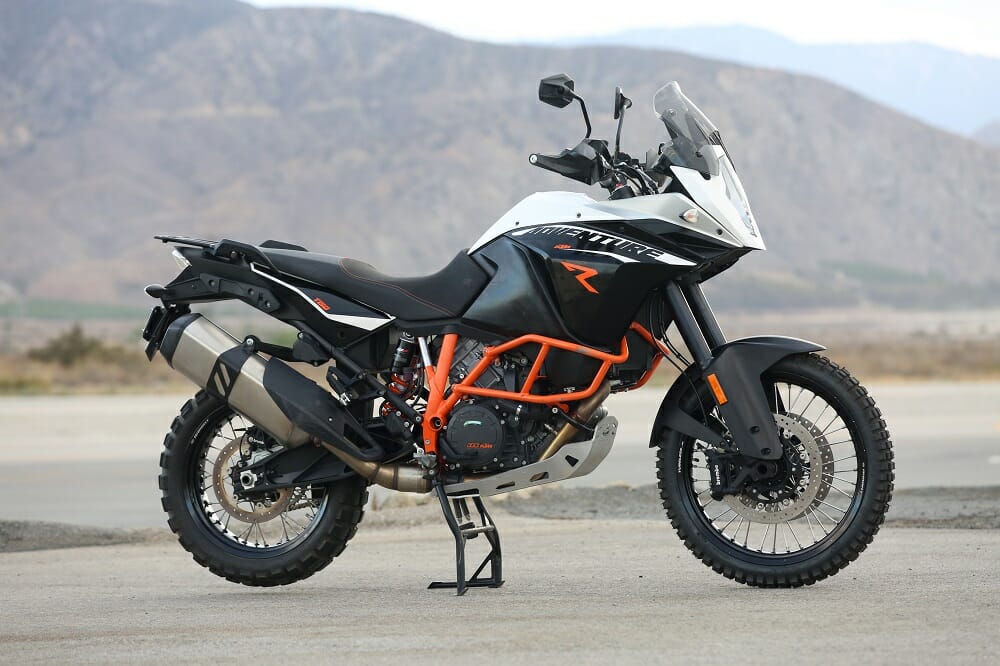
The Vitals: KTM 1190 Adventure R
|
Engine and gearbox: |
1195cc, V-Twin, six-speed |
|
Chassis, suspension and brakes: |
Tubular steel trellis frame, WP electronically adjusted 48mm inverted fork and single shock absorber, Brembo four-piston radially-mounted front brake calipers and 320mm disc, Brembo twin-piston rear brake caliper and 267mm disc, ABS |
|
Seat height: |
33.8 in. |
|
Fuel capacity: |
6 gal. |
|
Weight: |
518 lbs. (wet, claimed) |
|
Electronics: |
Four-stage riding modes, traction control, ABS |
|
Power: |
148 hp @ 9500 rpm (claimed) |
|
Torque: |
92 lb-ft @ 7500 rpm (claimed) |
|
MSRP: |
$16,999 (base, no accessories) |
1st Place – Honda CRF1000L Africa Twin
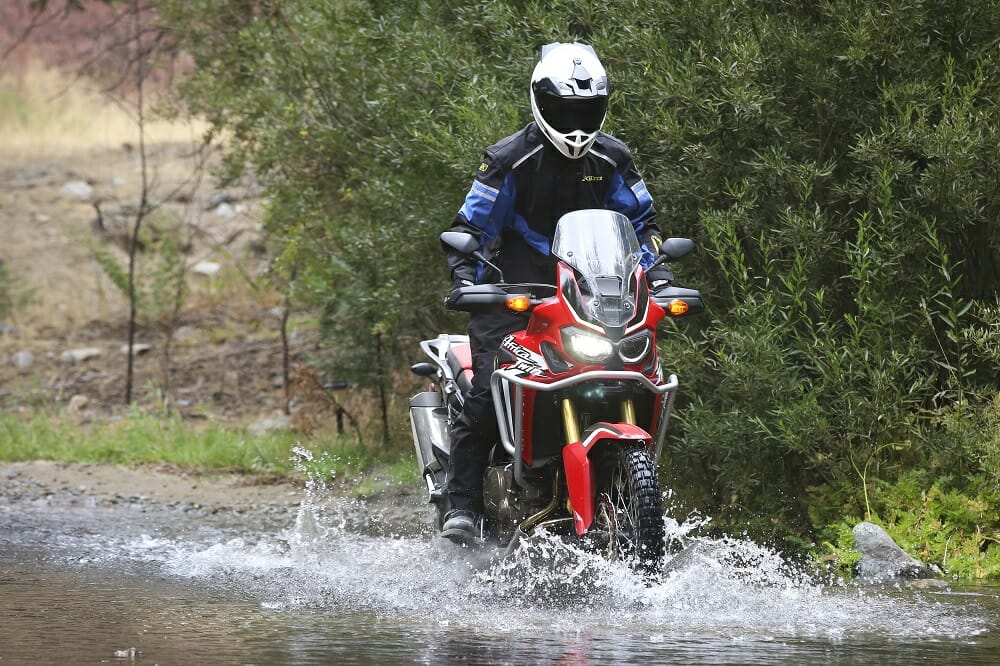
There’s something to be said for the “less is more” phrase. The Honda is the least technically advanced machine here, it’s got traction control and semi-switchable ABS (you can turn it off at the rear but not the front), and that’s it as far as electronics go. There are no heated grips, no cruise control, no variable engine maps.
So why the hell have we voted it number one? Simple, really. Because in the business of actual adventure riding, both off- and on-road, the Honda was the best bike here.
The Honda is the least intimidating, easiest bike to ride in the shootout. It’s got nowhere near the power of the KTM or Ducati, and has a size-eight bum compared to the size 12 of the BMW. The lack of girth allows more riders of varying skill levels to ride to further away places without thinking they’ll get stuck—which is the whole point of adventure riding.
Like many of the company’s bikes, the Africa Twin does everything really well and nothing outstanding. The parallel-twin motor has enough go in it for 99.9 percent of all ADV scenarios, and the suspension strikes the perfect mix of off-road compliance and on-road comfort. It doesn’t have the pizzazz of the KTM or Ducati, but it’s also much, much cheaper, and you can do a lot to a bike with a few grand left in your pocket (as long as you buy this standard gearbox version and not the DCT model, which will set you back an extra $700).

The Africa Twin’s electronics are simple at best, and like the KTM’s, are annoying as hell in that they default to factory settings when you switch off the ignition. There’s also a bit of a budget feel to the finish like the cable-actuated clutch and throttle, crappy footpegs and tubed tires, but it also means this bike is easily fixable if one of said parts breaks in the middle of nowhere.
I can personally attest to the build quality of the Africa Twin after a near 700-mile Vegas to Reno race on one with Johnny Campbell—we bashed that bike to high hell and it kept coming back for more—and there’s no way I’d have done that race on the Ducati or BMW.
The Honda lacks inspiration in the design. It doesn’t get the juices flowing like any of the other bikes on test, but the simple fact is the Honda is the bike we’d all put our money down for at the end of the test.
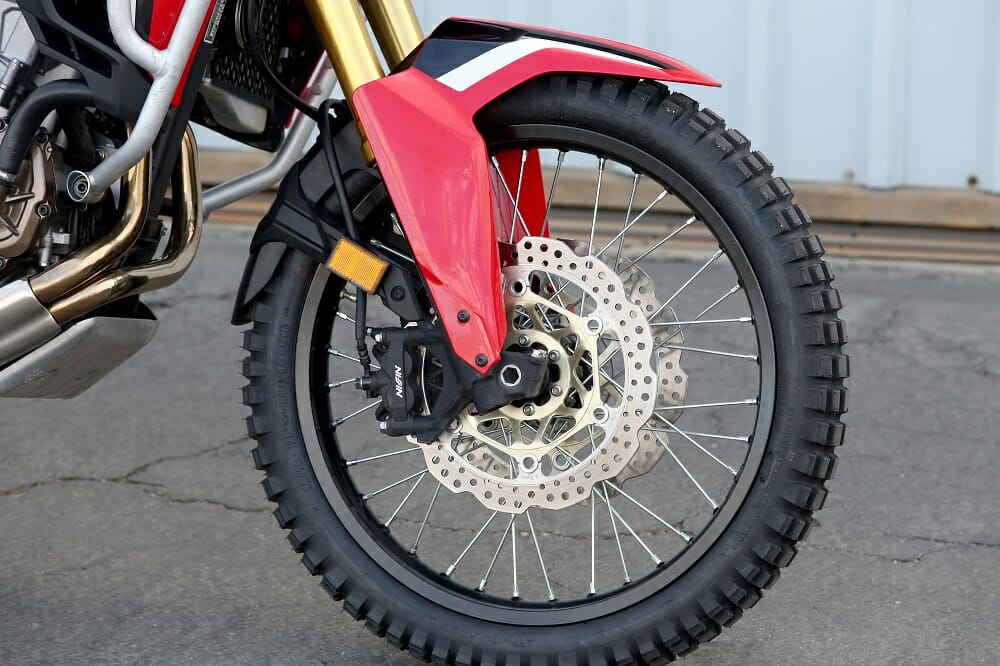
Jesse Ziegler: “The AT simply blew me away with how capable it seemed and how well it performed at every single task I threw at it. Off-road sections were handled with ease—easier than with the KTM thanks to the smoother power delivery and easier-to-set TC and ABS. There isn’t a place the Honda underperforms other than excitement. It is quite possibly the most versatile of the bunch and does everything with much less intimidation. It doesn’t feel big; it feels nimble and light. It isn’t overly tall—it just feels normal. And sort of boring. But boring is good if you’re in the backcountry and need your machine to simply work. Highlights include a dialed-in suspension set up great for the U.S. market, roomy ergos without making it a towering beast, smooth controllable power, impressive street handling chops and simple electronic options. What holds it back are small things—a basic cable clutch and absolutely laughable footpegs seem almost embarrassing—but I give the clutch a pass because, again, it simply works. The footpegs are atrocious and the aftermarket is drooling at the chance to outfit AT owners in proper platforms.”
Sean Finley: “If you are going to spend a lot of time off-road, especially in more challenging roads or trails, the Africa Twin is the bike. The ergonomics are good for either sitting or standing in off-road conditions. The suspension works really well off-road and is better balanced than the KTM. It also works well on the road. As far as engine maps and ABS go, you have three options on the TC (which can be changed while riding) and you can turn off the rear ABS for off-road use with a simple button. I liked the simplicity. But, there’s no standard center stand, which is a must for ADV bike. Honda OEM and aftermarket centerstands are available in the $200 to $300 range. I think it is important to point out that the Honda has a lot of low-tech items that contribute to the significantly lower cost. Cable clutch and throttle, no center stand, spoked rims that require the use of tubes (rather than tubeless) and significantly reduced electronic options (fewer map options, no outside air temperature, tire-pressure monitor, ABS that does not include lean-angle monitoring). The BMW and Ducati also include electronic suspension control and setting options.”
Kit Palmer: “The first thing I think about when it comes to adventure riding is long distance and for me the Africa Twin is the bike I want to be on for those endless days in the saddle. The Honda is an extremely comfortable motorcycle for both street and dirt riding. Ergos are just right, the seat is firm yet not too firm (and just wide enough), and the bike as a whole is anything but intimidating. It doesn’t feel overly big between your legs, seat heat is totally acceptable and the engine is extremely user-friendly, while still pumping out impressive power.
The Honda just has that “cush” feel about it that really strikes the right chord with me. Suspension is outstanding and handling is solid, and the Africa Twin has just enough electronics to significantly reduce workload for those long days on the road. And the electronic controls are simple to use and easy to remember, which is a good thing since it resets itself every time you shut off the engine. That, I could do without. Overall, I found the Honda to be just as good on the street as it is on the dirt, and a complete overall package that, in my book, just can’t be beat.”CN
The Vitals: Honda CRF1000L Africa Twin
|
Engine and gearbox: |
998cc, Parallel-Twin, six-speed |
|
Chassis, suspension and brakes: |
Steel double-cradle chassis, Showa inverted fork and single shock absorber, Nissin four-piston radially- mounted front brake calipers and 310mm disc, Nissin twin-piston rear brake caliper and 256mm disc, ABS |
|
Seat height: |
34.3 in. |
|
Fuel capacity: |
4.97 gal. |
|
Weight: |
511 lbs. (wet, claimed) |
|
Electronics: |
Three-stage traction control, ABS |
|
Power: |
Not given |
|
Torque: |
Not given |
|
MSRP: |
$12,999 |
